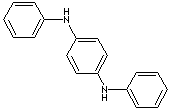N,N'-DIPHENYL-p-PHENYLENEDIAMINE
PRODUCT IDENTIFICATION

CLASSIFICATION
PHYSICAL AND CHEMICAL PROPERTIES
1.2
APPLICATIONS
N,N'-Diphenyl-p-phenylenediamine is used as an antioxidant and/or stabilizer for rubber, petroleum oils and feedstuffs. It is also used as a polymerization inhibitor and a retardant against copper degradation.It is a chemical intermediate to make dyes, drugs, plastics and detergent additives.
Antioxidant is a substance added in small quantities to hydrocarbons which are susceptible to oxidation, such as rubbers, plastics, foods, and oils to inhibit or slow oxidative processes, while being itself oxidized. Antioxidants work in two different ways. In primary antioxidants (also called free-radical scavengers), antioxidative activity is implemented by the donation of an electron or hydrogen atom to a radical derivative. These antioxidants are usually hindered amines (p-Phenylene diamine, trimethyl dihydroquinolines, alkylated diphenyl amines) or substituted phenolic compounds with one or more bulky functional groups such as a tertiary butyl at 2,6 position commonly. Butylated hydroxytoluene (BHT) is a common example of hindered phenolic antioxidant. TThe reaction rate, or carbocation stability, in SN1 mechanism is 3° > 2° > 1° > CH3 (no SN1) so, tertiary alkyl moiety exists in lots of phenolic antioxidant compounds. Primary antioxidants are free radical scavengers which combine with peroxy radicals and break autocatalytic cycle. In secondary antioxidants ( also called peroxide decomposers), activity is implemented by the removal of an oxidative catalyst and the consequent prevention of the initiation of oxidation. Examples of peroxide decomposer type of antioxidant are trivalent phosphorous and divalent sulfurcontaining compound such as sulfides, thiodipropionates and organophosphites. Synergistic effect is expected when primary antioxidants are used together with secondary antioxidants as primary antioxidants are not very effective against the degradation by UV oxidation. Sometimes, chelating agents are added to scavenge metal impurities which can initiate decomposition.p-Phenylenediamine is used as a parent compound in vulcanization accelerators and in antioxidants for rubber industry. PPD is chosen because it imparts high temperature stability, high strength, and chemical and electrical resistance. Examples of the most widely used anitioxidants or antiozonants derived form p-phenylenediamine are N-isopropyl-N'-phenyl-p- phenylenediamine (IPPD, CAS # 101-72-4) , N-Cyclohexyl-N'-phenyl-p- phenylenediamine (CPPD, CAS #: 101-87-1), N,N'-Diphenyl-p-henylenediamine (DPPD, CAS # 74-31-7), and N-(1,3-dimethylbutyl)-N'-phenyl-p-phenylenediamine (6PPD, CAS #: 793-24-8). These derivatives are added to rubber products to retard degradation by oxidants and ozone.
APPEARANCE
80.0% min
135 C (Initial), 143 C (Final)
VOLATILE MATTER
0.5% max
ASH
0.5% max
Hazard Symbols: XI, Risk Phrases: 36/37/38, Safety Phrases: 26/37/39